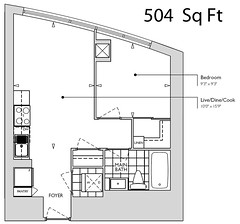Observer Walt
Senior Member
Down at "Victory", near King and Spadina, they offered an option of two units side-by-side which could be bought separately or together. The larger unit is either 765 sq. ft. (2 BR) or 930 sq. ft. ( 2BR + study). The smaller unit, located next door, is either 350 or 360 sq. ft. If you want small, I give you small!
The small units have essentially one room (living / dining / kitchen / sleeping), one closet, and a washroom with shower (no tub).
I don't know how the sales are going, or how many of the small units have been sold either as a combo with the large unit, or on their own.
Agreed with dt's comment, that experienced developers don't just sell these units without having done extensive homework first. I do think that many of these smaller units at Aura will be purchased by parents of Ryerson students, especially given that Ryerson has so little residence space. Compared to other student housing, this won't be so bad.
Whether it's a smart strategy to mix what may be "student housing" with some of the city's more prestigious units, in the same building, I'm not so sure.
The small units have essentially one room (living / dining / kitchen / sleeping), one closet, and a washroom with shower (no tub).
I don't know how the sales are going, or how many of the small units have been sold either as a combo with the large unit, or on their own.
Agreed with dt's comment, that experienced developers don't just sell these units without having done extensive homework first. I do think that many of these smaller units at Aura will be purchased by parents of Ryerson students, especially given that Ryerson has so little residence space. Compared to other student housing, this won't be so bad.
Whether it's a smart strategy to mix what may be "student housing" with some of the city's more prestigious units, in the same building, I'm not so sure.

